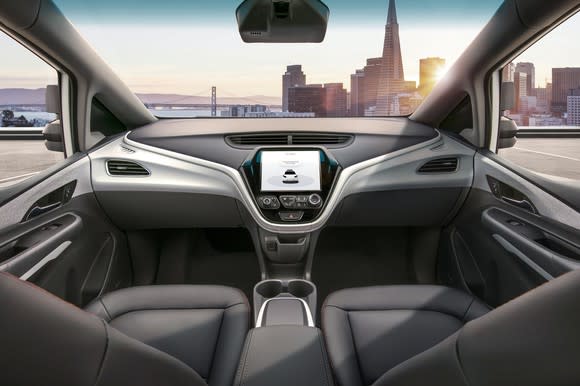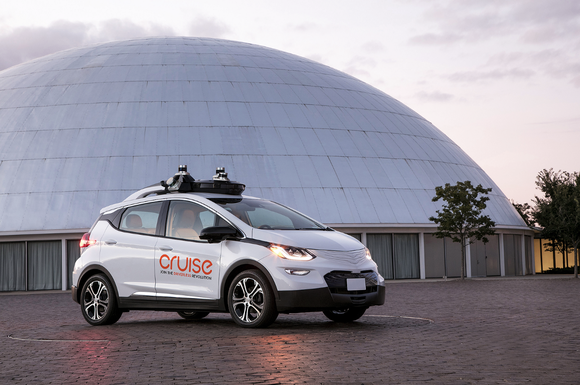Forget Tesla: This Photo Shows General Motors Is a Self-Driving Leader
General Motors (NYSE: GM) has asked the U.S. government for permission to build a self-driving car without a steering wheel or pedals -- in 2019.
This is a big deal. The photo below really brings it home: The future has arrived. And while many investors have been looking to Tesla (NASDAQ: TSLA) to deliver that future, it looks now like it'll come from Detroit instead.
Here's what we know.

The dashboard of GM's Cruise AV, a self-driving vehicle based on the Chevrolet Bolt EV. GM is asking the U.S. Department of Transportation for a waiver that will allow it to build and operate the Cruise AV on U.S. roads without a steering wheel or pedals. Image source: General Motors.
What it is: A new self-driving car based on the Chevy Bolt
For a while now, GM and its San-Francisco-based subsidiary, Cruise Automation, have been testing prototype self-driving vehicles on public roads. Nearly all of them have been based on the Chevrolet Bolt EV, the innovative long-range electric car GM began producing in late 2016.
GM said that this vehicle, the one without a steering wheel, is the fourth iteration of its self-driving Bolt. The changes from the human-driven version of the Bolt are now significant enough that GM gave it a new name in a nod to the group that created it: Cruise AV.
But note that the Cruise AV still largely a Bolt, meaning that it can (and will) be built on the Bolt's existing assembly line in Orion Township, Michigan.
(Interestingly, the Cruise AV has no Chevrolet badges, and GM isn't calling it a Chevy. GM's press materials refer to it as simply the "Cruise AV".)

From the outside, the Cruise AV looks very much like this vehicle, which GM presented in September as the third iteration of its self-driving Chevrolet Bolt. Image source: General Motors.
If you're hoping to buy one, hold on: GM doesn't appear to be planning to offer the Cruise AV to retail customers. It's being designed for ride-hailing duty in "dense urban environments": It's a taxi.
Why the Cruise AV is a big deal
For starters, look at the top photo again, the one of the dashboard. Such sights will likely be familiar to city-dwellers in a few years, but here in early 2018, it's remarkable.
It's also impressive because of the timeline. In November, when GM gave investors an elaborate presentation on the state of its autonomous vehicle program, it made clear that it would deploy its self-driving system only when it was convinced it could operate a vehicle more safely than a human driver. Based on the system's rate of improvement, GM then estimated that would happen in 2019.
But today, in its press materials and even a tweet from CEO Mary Barra, GM seems quite clear that it will deploy the Cruise AV in 2019.
Today we took another step on our journey to safely deploy self-driving cars in 2019 and help bring our vision of a world of zero crashes to life. https://t.co/8VcLZ4OBL8
— Mary Barra (@mtbarra) January 12, 2018
That's important for reasons beyond excitement about the future. GM has argued, persuasively, that the first company to deploy fully self-driving vehicles at scale will realize a significant first-mover advantage.
Here's why: Self-driving systems learn and improve as they rack up miles and encounter new situations, and the vehicles share that learning. The more miles traveled, the more the overall system learns. Having thousands of self-driving vehicles operating in several different urban environments will help the system learn and improve very quickly. As the it improves, it'll offer higher-quality rides -- rides that are smoother and more direct.
Cruise CEO Kyle Vogt explained it well with this slide in a presentation in November.

GM will deploy its self-driving system when the lowest two levels of the "pyramid" are met. As the system gains experience, it will ascend through the remaining levels. Image source: General Motors.
That's the advantage: GM thinks that riders will gravitate to the ride-hailing company with the best system, the one that "just works," time after time. The first to deploy at scale will likely hit that level of service sooner than rivals, giving it an opportunity to build significant share early in the game.
The upshot: GM is saying a lot with this announcement
Long story short: To the extent that there are big profits to be made in automated urban ride-hailing vehicles, the first company to put large numbers of them on the road will be in position to capture a major percentage of those profits.
GM wants to be that company, and today's announcement is intended in part to show investors that it's on track to be. Given how well it has delivered on its past promises under Barra's leadership, I think investors should take it very, very seriously now.
More From The Motley Fool
John Rosevear owns shares of General Motors. The Motley Fool owns shares of and recommends Tesla. The Motley Fool has a disclosure policy.